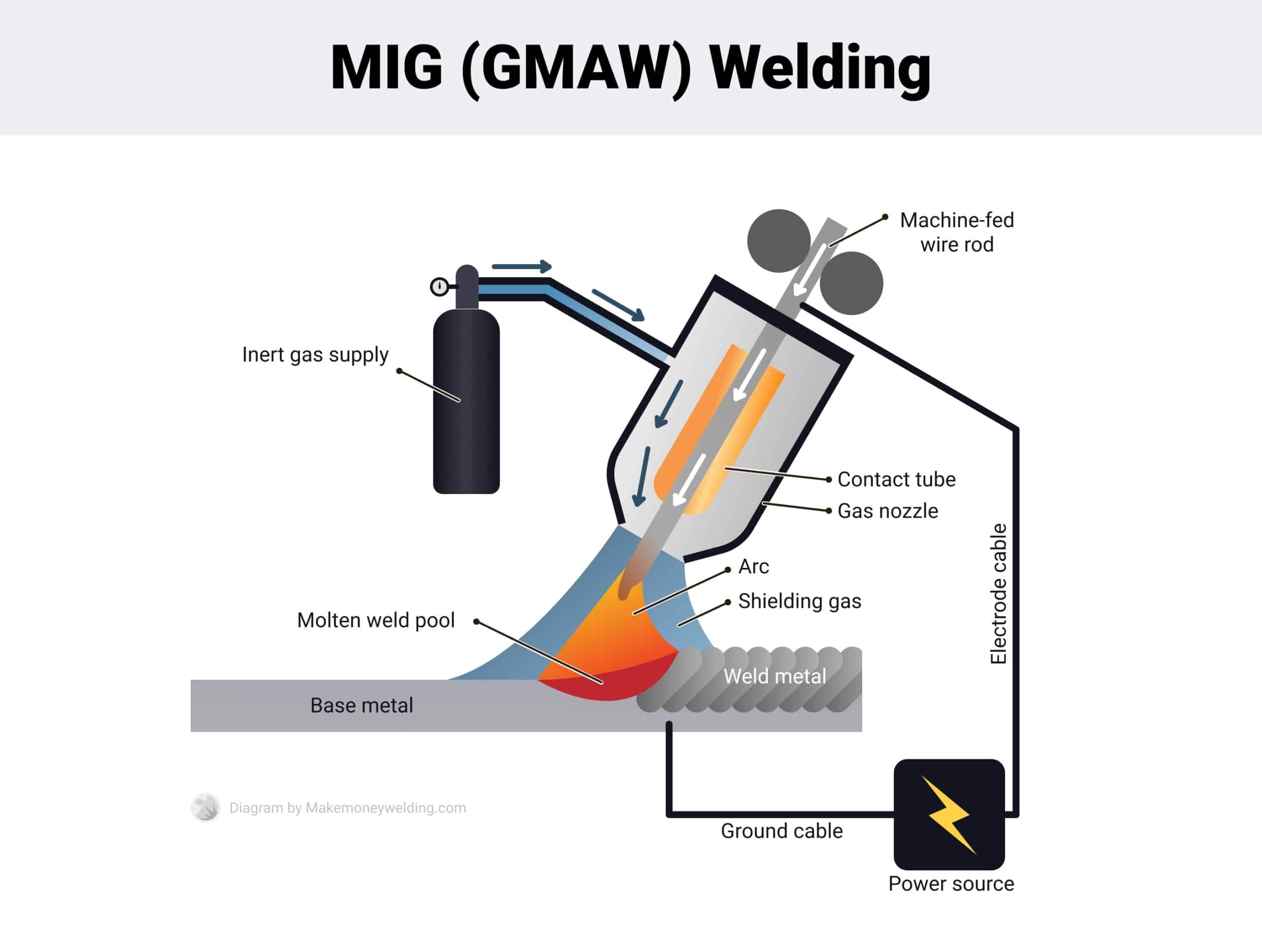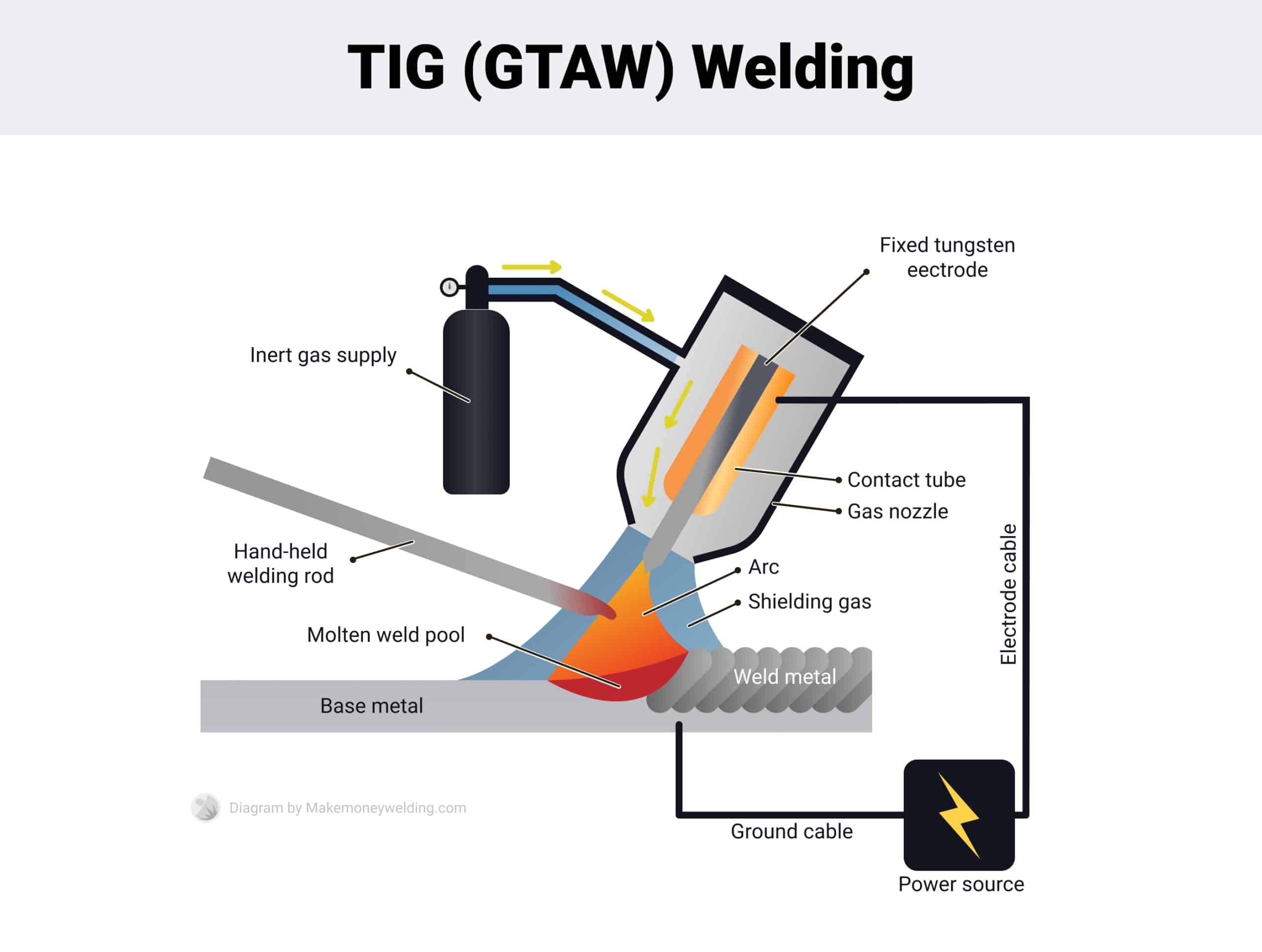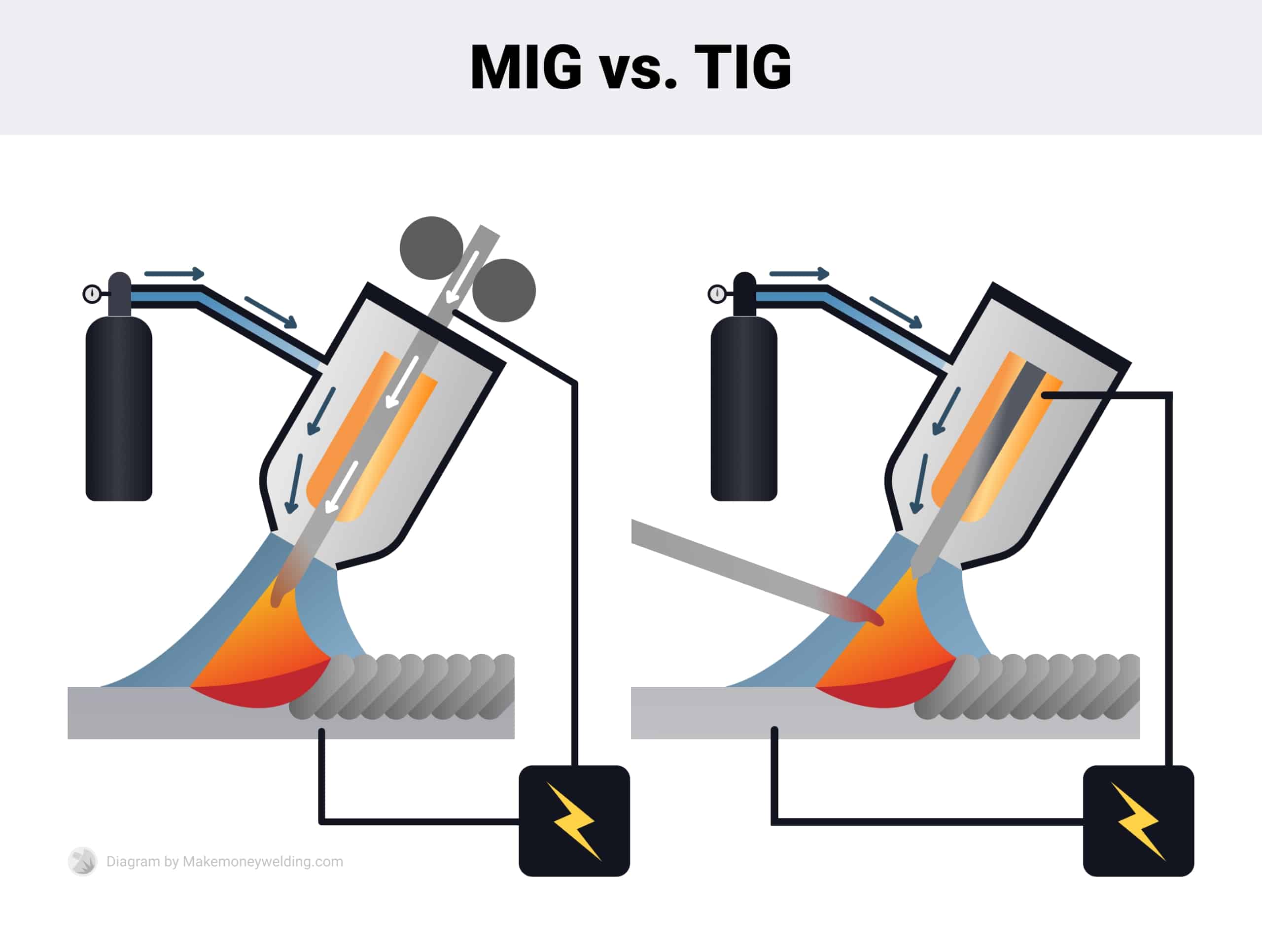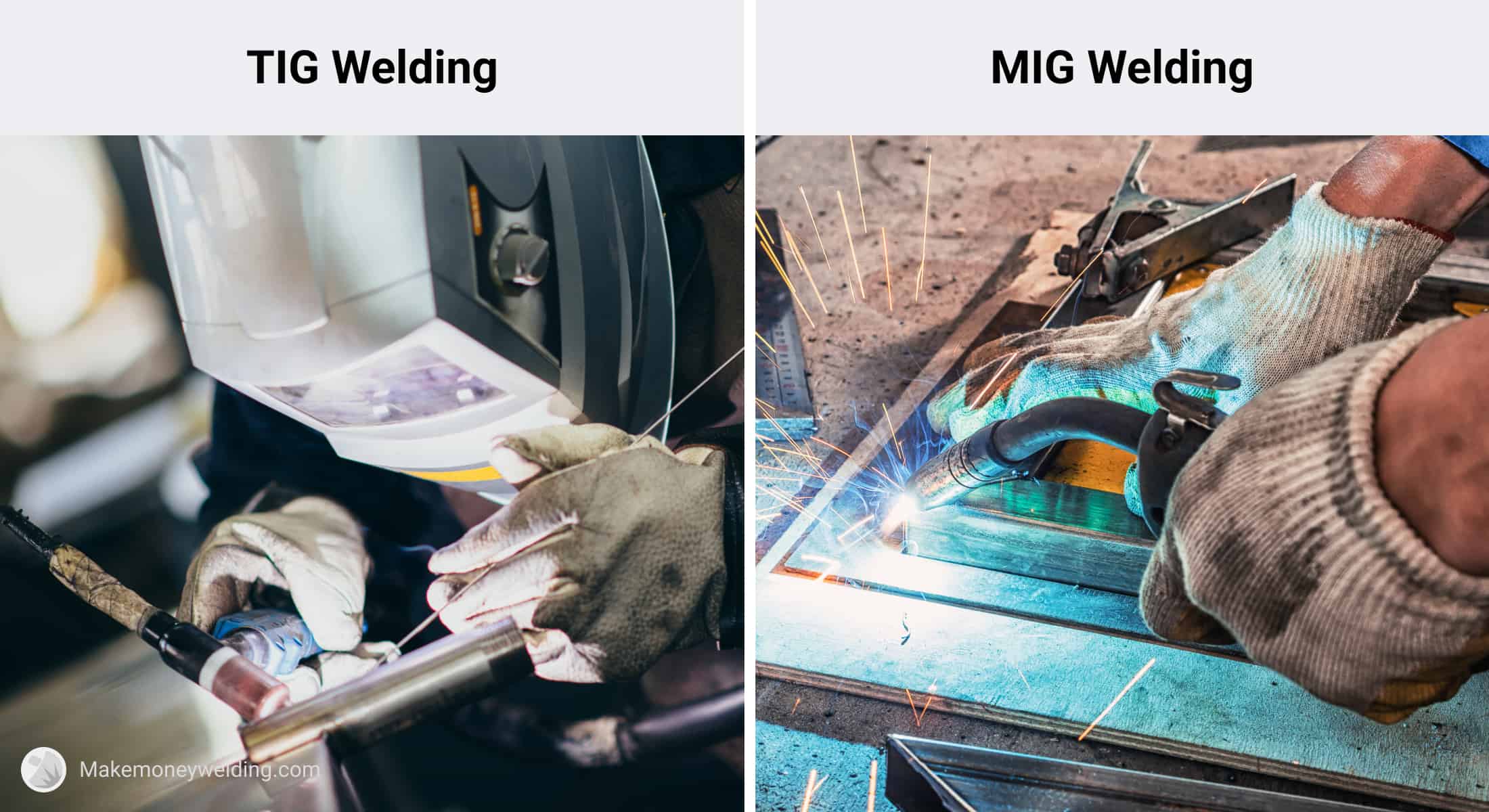MIG and TIG welding are two of the most-used electric arc processes.
Their main differences are the electrode used to create the arc and their overall performance. MIG (metal inert gas) welding uses a consumable solid wire quickly fed into the welding pool, whereas TIG (tungsten inert gas) welding uses a fixed electrode and a separate hand-held filler rod to create a precise join.
In the following article, we will be reviewing the differences between the two. So you can decide which is right for you.
Summary of the MIG & TIG Processes
Before diving into the differences between MIG and TIG, it’s essential to understand how they both work:
How Does MIG Welding Work?

MIG welding, also known as GMAW (Gas Metal Arc Welding), is a process that uses consumable wire as the electrode and filler metal.
This wire is delivered continuously through the torch (also known as a “gun”) to generate an electric arc that heats the metal and the wire to create a welding pool. This welding pool must be protected from contamination using a shielding gas mixture, usually argon and CO2.
How Does TIG Welding Work?

In contrast, TIG welding, also known as GTAW (Gas Tungsten Arc Welding), uses a non-consumable tungsten electrode to generate the arc and produce the weld. It heats the surface metal while the filler metal is fed and moved separately into the weld pool as needed.
This process requires precise amperage control; therefore, welders often have a pedal and use pure Argon to protect the weld and tungsten from harmful oxidation.
MIG vs. TIG Compared

MIG and TIG are similar in function but differ in performance. They both use electric arcs to heat and shielding gases to prevent contamination and increase quality; however, from a performance standpoint they are completely different.
Let’s take a deeper look:
Which Is Strong?
MIG welding arcs produce significant and high heat input, but the arcs spread out over a wide area, causing less penetration than a TIG weld. A TIG weld has a narrow, more focused arc that is better at penetrating the metal, making it stronger.
There are, however, ways to increase penetration and strength in some MIG welds. These methods include cutting a V groove into the joint, a suitable welding technique, and selecting the correct gas mixtures.
Winner: TIG
Which Is Faster?
Achieving the said strength with TIG requires time. This is because TIG welders need to feed their chosen filler metal into the weld pool by hand.
MIG welding is way faster than TIG. This means you can produce more welds in the same amount of time and is the preferred choice when you have a lot of material to cover and continuous seams to weld. For assembly line tasks where speed and consistency are more important than appearance, MIG is often the way to go.
Winner: MIG
What Welds Look Better?
When done correctly, TIG welds look much better than MIG welds. Beads are more uniform, robust, and professional. Also, TIG welding’s accurate heat control makes it easier to weld thin metals.
TIG achieves the sought-after visual effect of “stacked dimes” and makes less of a mess since it hardly ever creates any spatter.
On the other hand, MIG welding makes relatively good-looking welds. Surface treatments like painting may help increase its overall look.
As you can see in the pictures above, MIG arcs are wider, bulkier, and cover a much broader area. On the other hand, TIG arcs are more efficient and generate more concentrated heat. This results in hotter, finer welds that, apart from light polish, don’t require any other finishing.
Winner: TIG
Welding Different Types of Metals
MIG can weld virtually any type of metal because you can change parameters and the shielding gas composition accordingly. This isn’t an issue for experienced welders. On the other hand, beginners usually find themselves stuck using a specific type of material until they gain the knowledge and equipment needed to branch out.
Another important thing to consider is the power source since it depends on the metal you want to weld and the electric arc you choose.
Which is Better for Steel?
MIG welders primarily weld steel because the aesthetics aren’t too critical.
Steel is known as the dirtiest of metals, and is often coated or painted after fabrication, so steel welds are better performed with a quick MIG weld capable of burning through dirt more easily than a TIG weld.
Winner: MIG
What Process Is Better At Welding Aluminum?
TIG welding is the preferred choice for welding aluminum because of its ability to use an alternating current (AC), use fine heat control to weld thin sheets, and produce better-looking welds.
Aluminum has good heat transfer characteristics. It hardly erodes because of the natural layer of oxide that forms when exposed to oxygen. When MIG welding, this layer must be removed with a stainless steel brush before welding.
However, when TIG welding with AC, the oxide layers are better removed than in direct current (DC) welding, making it superior. TIG welding’s power source can be AC or DC, while MIG welding uses a DC power source.
In addition to cleaning the surface, MIG welding aluminum requires the purchase of a spool gun to feed the aluminum wire, and you must change the shielding gas to use 100% argon to prevent oxidation.
Winner: TIG
What Process Is Better At Welding Stainless Steel (SS)?
Even though plenty of people use MIG welding for stainless steel, TIG welding is the method of choice for SS welds. Since stainless steel is expensive and doesn’t usually require any finishing, you might as well keep its premium look.
But it is not all about aesthetics. TIG welding, unlike MIG, generates a focused and controlled heat input that helps to prevent material distortion during cooling.
However, if you need high production rates, are welding out of position, or are dealing with complex joints, MIG might be more appropriate.
Winner: Tie
Gases
As mentioned, both MIG and TIG processes use a shielding gas. Shielding gas protects the welded material from defects, oxidation, cracks, and porosities. Shielding gas also protects the electrode.
The tungsten electrode in TIG cannot stand oxidation; Therefore, an inert gas like argon or helium helps to protect TIG welds from the oxidative effects of atmospheric air at high temperatures.
The speed of MIG requires both oxidation control and arc stability; therefore, argon-CO2 mixtures are used to protect the weld pool since CO2 increases both viscosity and penetration.
Related: What Gas Should You Use for MIG Welding?
For more specialized jobs, you might also take a look at technical mixtures of argon with other gasses:
- Oxygen: Promotes good welding speed and fluidity in the molten pool.
- Hydrogen: Makes for better penetration and speed and contributes to a “cleaning” effect (oxide removal).
- Helium: Promotes heat input, speed, and penetration for some specific non-ferrous metals.
Winner: Tie
Which Process is Easier to Learn?
As you may see in the pictures below, TIG welding has a steeper learning curve. Welding with TIG involves using both hands and one foot.

One hand holds the electrode, the other constantly feeds the filler, and a foot actuates a pedal to control amperage as you weld to change the heat. This makes it a highly technical process that requires a fair amount of skill and mastery to do it properly.
MIG is an easy process for beginners; you can even weld lying on your back! On the contrary, TIG needs time to master; however, learning is worth it! Many business opportunities in the automotive industry are associated with TIG welding.
An analogy for you to understand is to think of MIG as an automatic process and TIG as a manual process.
Winner: MIG
What Process is Cheaper To Run?
MIG welding is generally cheaper to set up and run compared to TIG.
Let’s take at look why…
Equipment Cost
A TIG welding machine is a significant investment. Buying or renting a TIG machine can set you back almost double what you’d spend on a comparable MIG.
A TIG welding machine is worth the cost if you’re doing a lot of welding where precision counts, such as value-added assemblies or high-performance products.
Labor costs
According to ZipRecruiter, as of October 28, 2022, the average hourly pay for a MIG welder in the United States is $17.31, while the average for a TIG welder is $19. In addition, MIG welding can also be robotic, making it cheaper to operate.
Keep in mind that, as stated above, TIG welding has lower production rates, so it takes more hours to complete a piece; therefore, a TIG weld’s total labor cost will always be higher than a MIG weld’s would be for the same piece.
Note that prep work (cleaning and sanding) is also reduced in the case of MIG welding.
Material costs
Consumables for TIG welding cost slightly more (approximately $5/lb., versus $3/lb. for a MIG wire). However, in some cases, TIG welding can be performed without filler materials, since penetration control is higher.
Gas costs
Usually, TIG welding uses pure argon or specialty mixtures, while MIG processes use either a blend of argon and carbon dioxide (75% argon, 25% CO2) or pure CO2, which is cheaper and improves weld penetration (though there are some disadvantages, like increased spatter).
Another thing to consider is that a MIG weld requires 35–50 cubic feet per hour, in contrast to the 15–25 cubic feet per hour required by a TIG weld.
Winner: MIG
Summary Of The Differences
| Performance Indicator | MIG (GMAW) | TIG (GTAW) |
|---|---|---|
| Productivity | High | Low |
| Quality | Some spatters and fumes | High |
| Aesthetics | Lower | Higher |
| Strength | Lower | Higher |
| Learning curve | Short | Steeper |
| Metals | Thick | Thin |
| Cost | Lower | Higher |
Best Applications for MIG & TIG
If you access to both MIG and TIG, it’s worth noting what to use based on your application.
- For stock thicknesses: You can weld thick metals faster using the MIG process. But, if you are working with thinner metals or parts, using the TIG process may be better.
- For long runs: Manufacturers design MIG guns to run continuously over long periods, making them more efficient and productive than a TIG torch. On top of that, MIG welding works very well in automated welding environments.
On the other hand, TIG welding is a much slower process, capable of welding parts with small details.
- For welding out of position: MIG is more comfortable in difficult positions as you only need one hand to hold the gun. On the contrary, TIG achieves better results when bench welding or inside the shop since it is a challenging process to manage when out of position.
- For production rates: MIG welding is ideal for large projects with thick parts, repetitive welds, and high productivity. On the contrary, TIG can offer greater weld detail and is convenient for jobs that require more spot welds.
- Welder experience needed: As we discussed earlier, MIG and TIG differ by technique. You will find it easier to use the MIG process. However, experienced or skilled welders can adapt to TIG.
TIG welding can be a little more complicated for those already used to MIG.
Both methods can weld a wide variety of metals. Therefore, its selection for a given application in the industry is made to take advantage of its core characteristics.
Here’s a summary:
| Applications | MIG | TIG |
|---|---|---|
| Stock thickness | Best for thicker stock | Best for thin stock |
| Length of runs | Longer | Shorter |
| Welding positions | Comfortable in all positions | Difficult out of position |
| Production rates | Higher | Lower |
| Experience needed | Low | High |
Frequently Asked Questions (FAQ)
Is TIG or MIG better for beginners?
MIG is the obvious choice for beginners, as it is a semi-automatic process requiring you only to pull a trigger to weld (which also makes it quicker). TIG welding is a slower, more complicated process that requires more dexterity as you must use both hands simultaneously and a foot pedal to control the heat output.
Is it better to use MIG or TIG welding on stainless steel?
It depends on what results you are trying to achieve. If you want aesthetically-pleasing welds, then TIG welding is the way to go. If you are looking for speed and efficiency, MIG welding may be a better process.
How do MIG and TIG compare to stick welding?
The main difference is MIG and TIG require an external shielding gas to protect the weld, whereas stick welding does not. The stick electrode, or rod, contains a flux that shields the weld when the arc is started.
This makes it ideal for outdoor welding as no gas needs to be transported, and it is not prone to windy conditions.
Final Thoughts – Which is Better?
We have come to the end of our MIG vs. TIG comparison! We analyzed in detail both MIG and TIG processes. Therefore, we learned that when it comes to cost and speed, MIG is the preferred solution and that for some projects where precision and control are required, TIG welding is optimal.
The MIG process is more common today than TIG because it’s easier to learn and is a much faster process. However, both systems perform well in different situations, which is why many welding shops have both.
Projects to use MIG:
- Larger projects with thicker metals.
- Continuous welding and high productivity, as it can withstand long periods of welding.
Projects to use TIG:
- Small projects with thinner metals.
- Welding projects that require greater precision and better finishing.
Pro tip: Continuous welding gives less chance of defects because it reduces the need to stop and restart the welding every time.
Thanks for reading this article. We hope you enjoyed our comparison of MIG and TIG welding and found the one that better fits your needs. If you have additional questions, please feel free to ask them in the comments section below!


